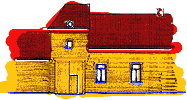|
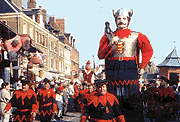
Giants, led by Jean le Bûcheron,
in the streets of Steenvoorde in April. Many festivals
include processions of visiting giants, as well as those of
the town.

Colourfull umbrellas - sometimes still home-made - are part
of the street celebrations in Dunkerque.
|
"Géants" and town
carnivals
You're standing in a huge, happy and very noisy crowd lining
the streets of the North Sea fishing port of Dunkerque.
You're enjoying a sip of the local beer, watching some very
strangely dressed men wave umbrellas. They cheer as a
fife-and-drum band dressed as Napoleonic soldiers marches
past. Suddenly a huge looming figure, 20 or 30 feet high,
sways into sight as part of the procession. It's the town
giant!
Religious origins
This colourful Flemish tradition dates back to the
Counter-Reformation
in the early 16th century. It came from Spain and Portugal,
when Flanders was part of the Spanish Netherlands. The
Catholic church set out to encourage popular expressions of
piety to ward off the threat of Protestantism.
Early "Géants"
Large figures were carried in annual religious
processions to mark occasions such as the day of the town's
patron saint. Most were biblical figures like Goliath or St.
Christopher, and they gradually acquired various attendants
in masks and costumes. The giants were traditionally made of
flexible wickerwork, and they could actually dance with the
music of the procession. In Douai,
the townsfolk had their processions banned by bishops
because they were getting too pagan!
Folk art
The French
Revolution in 1789 was
anti-church and atheist: the first republic banned the
giants, and destroyed many of the figures. Napoleon
permitted more secular giants to return, but the popular
tradition was not fully revived until the restoration of the
French monarchy in 1814. New characters were created,
generally local heroes or legends. The tradition developed,
and giants became the centrepiece of northern town's festive
carnival processions.
|
|
“Outings”
Giants are only seen on special occasions. Each town has a
voluntary association, which keeps up the tradition, looks
after and repairs the giant figure, and provides the bearers
and attendants who accompany the giant as he or she dances
through the streets - while bands play a special giants'
tune.
Look out for gatherings of giants when
one association invites other giants as guests to a special
procession. Sometimes there are “weddings”! There
are over 200 of huge figures, and they usually represent
some significant episode in the turbulent history of these
border towns. Some of the characters are centuries old,
others are quite recent inventions. Aging figures need to be
replaced - a good excuse for a “christening”.
Dunkerque carvival
For two months (late January to early March), Dunkerque
celebrates the festival that once gave a cheerful send-off
to fishermen sailing north to fish in the dangerous icy
waters round Iceland.
Each weekend a different group holds a
procession, with crowds of carnival revellers led by a band,
and featuring visiting "giants" such as the
Scandinavian warrior Reuze Papa and his wife from Cassell.
In the evenings each group holds a lively ball.
|
|
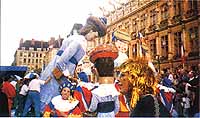 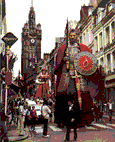 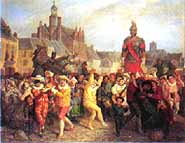
1.
"Binbin" - the 3.25 metre-tall
Valenciennes giant, in the September carnival
2.
Monsieur and Madame Gayant, Douai's giants are even
bigger! There are 6 men inside Monsieur Gayant.
3.
"Reuze Papa" in a 19th century
procession in Cassel. Painted in 1876 by Alexis Bafcop,
brother of the Ambroise Bafcop who created the giant in
1826. Alexis later made a "wife", called "Reuze Maman". The
couple were still appearing in parades in 1999, but both are
due to be replaced soon - due to old age.
|
|
Building a new giant
 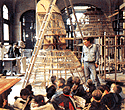 
1.
Lille's new giants were "born" in
1999: Lydéric (behind) and Phinaert - the
tough-looking ogre with the beard! Giants are living legends
- new ones are born almost every year....
2.
Building Lille's new giants - the wickerwork frame is
very light, and covered by the skirt. the man or men inside
see out through a flap in the cloth at eye-level...
3.
....The head is lightweight
papier-maché, sculpted and painted to suit the
character.
|

